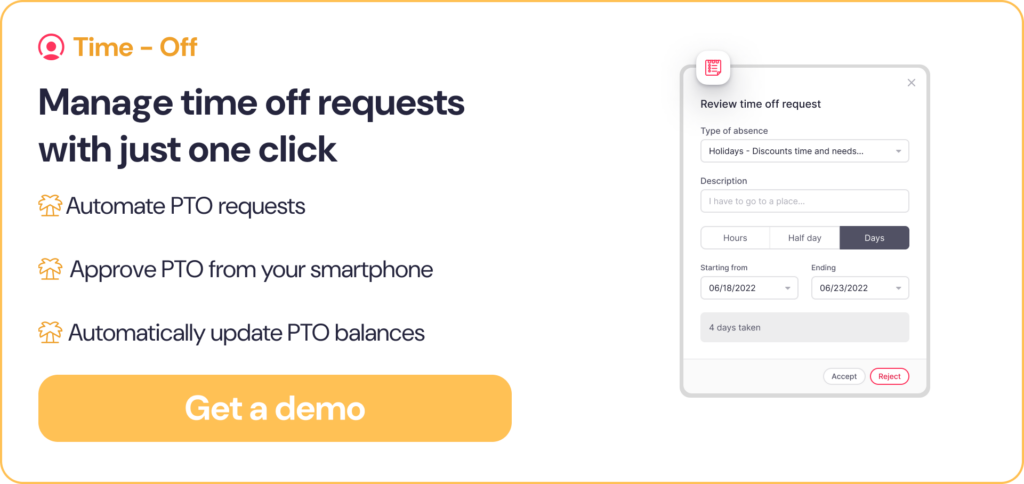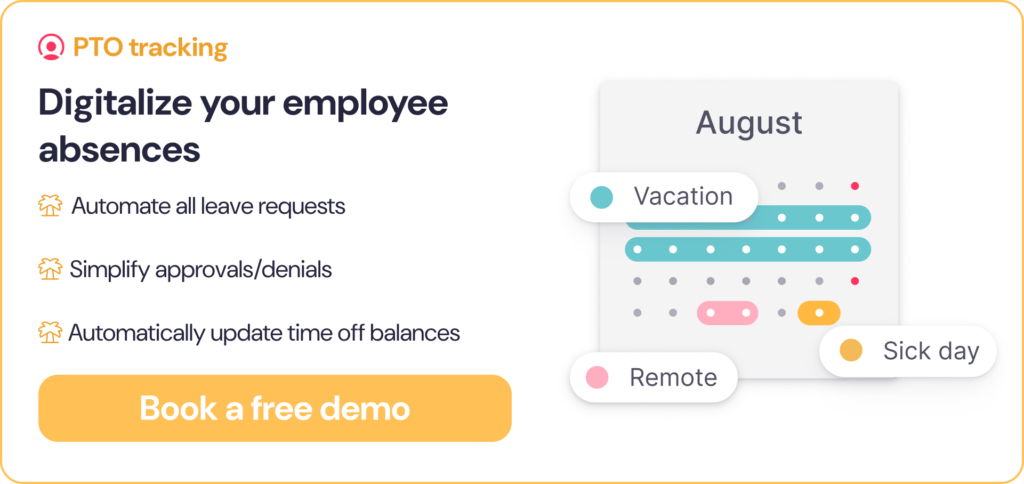Develop a clear leave of absence policy is a key responsibility of HR managers. A leave policy clearly outlines the various types of leave offered by a company. This includes time off for sickness, medical appointments, and statutory or contractual holiday entitlements.
As an employer, it is important to create a clearly detailed policy and communicate it to all staff. It must take into account all types of leave of absence and comply with all federal and state requirements.
In this article, we will outline all leave of absence types and explain when employees are entitled to a paid leave of absence. We will also look at how to write a leave of absence policy letter and what you need to include in your vacation request form.
TABLE OF CONTENTS
- Employee Leave of Absence
- Leave of Absence Laws
- PTO requests
- Leave of Absence Types
- Leave of Absence Policies: Best Practices
- Tracking Employee Absences
- Absence Tracker
- Vacation Request Form
- Transform your business with Absence Management Software ✅
Employee Leave of Absence Meaning
What is a leave of absence? A leave of absence (LOA) is an employee request for time away from work. It can be mandatory, governed by federal and state laws, or voluntary, governed by a company’s internal policies. LOAs can be paid or unpaid, and they can be requested for a variety of reasons:
- Personal or family illness or mental health issues
- Medical appointments
- Vacation
- Statutory or contractual holiday entitlements
- Bereavement leave
- Jury duty
- Pregnancy
- Military service
- Voting
- Personal reasons
Leave of Absence Laws
There are various laws that you must take into account when you write your absence policy. This will ensure compliance and a federal and state level of the leave of absence laws, and help you avoid any potential employee disputes.
- Family and Medical Leave Act (FMLA): most employers with over 50 employees must provide long-term unpaid sick leave to eligible employees (up to 12 weeks off in a 12 month period). FMLA leave can be requested for childbirth or adoption, serious health conditions, or caring for a family member.
- Americans with Disabilities Act (ADA): prohibits discrimination against employees with physial or mental disabilities. Employees can request ADA leave for medical absences related to their disabilities.
- Workers’ compensation laws.
- Regulations relating to wages, hours, and overtime, such as The Fair Labor Standards Act (FLSA).
PTO Requests
Paid Time Off (PTO) refers to an absence where an employee is still paid by the company. This can include sickness, vacation time, and personal time off. Paid time off can be mandatory or offered at the discretion of the company. Many companies offer a generous PTO policy to promote a good work-life balance and encourage employee wellness and loyalty.
A PTO request could be one of the following:
- Vacation leave. As a company you must decide how many days of paid vacation you will offer, and whether they will be assigned at the start of the year, or accrued throughout the year. Most employers offer full time employees at least 2 weeks (10 days) of paid vacation.
- Family and medical leave. Eligible employees are entitled to time off under the FMLA. Employees may also be eligible for injury or illness-related leave under the ADA.
- Many companies also include personal time off in their PTO policy, although there is no legal requirement to do so.
Employees should use a leave of absence letter to request paid time off. The serves as a written record of the notice they are giving.
Leave of Absence Types
Aside from the PTO requests we have just seen, employees can also request the following types of leave of absence:
Jury duty leave
Although there is no federal law regulating this, most states have laws prohibiting employers from penalizing employees for serving on a jury and ensuring job restoration (returning to the same duties). Eight states have also made it mandatory for employees to be paid for jury duty leave: Alabama, Colorado, Connecticut, Louisiana, Massachusetts, Nebraska, New York, and Tennessee.
Voting leave
There is no federal right to take time off work to vote, but most states have laws requiring employers to provide employees some voting leave benefits. These benefits could be paid or unpaid.
Bereavement leave
Only one state, Oregon, has passed a law requiring employers to provide bereavement leave. However, many employers choose to include compassionate leave in their paid or unpaid leave policies.
Voluntary leave
There is no federal or state requirement to offer paid or unpaid voluntary leave. Employers decide whether to grant a request for voluntary leave according to their internal policies and procedures. Many companies will offer a certain number of days for personal reasons or events such as moving house, although this is usually unpaid.
Parental leave
Parental leave is important for the mental and physical wellbeing of new parents and their babies. It is an essential time for new mothers to get accustomed to becoming a parent and recover from the physical demand of childbirth. Additionally, it is an opportunity for the father to bond with the baby, which is incredibly important for both the baby and father.
In the US there is no singular set federally mandated paid leave. Americans may be entitled to paid leave through different state or federal laws. For example, paternal leave is required by law in California, New Jersey, and Rhode Island.
Annual Leave
Annual Leave is defined as paid time off work granted to employees for them to use in any way they want. This time off is normally paid at the same rate as if they would be working normally.
In the US, there is no federal or state statutory minimum paid holiday, or even paid public holiday. Paid leave is completely dependent on the employer. Some companies do not offer paid holidays, whilst others do.
On average, in the US, employees are entitled to 10 days off after having worked for a company for 1 year, then after having worked for 5 years or more they are entitled to 14 days off, after 10 years are entitled to 17 days of holiday, and after 20 years receive 20 days off. This is a stark contrast to the annual leave which Europeans receive.
Leave of Absence Policies: Best Practices
Prioritize DE&I and Inclusive Holidays
While most companies recognize federal holidays such as Christmas Day and Labor Day and may not cater to the needs of people from other countries or those that belong to different religions.
Due to this, some companies have begun offering floating holidays. This means that employees can swap their time off from the holidays they don’t celebrate for the holidays that they do. This concept of a floating holiday caters to all needs in the workforce and is a lot more inclusive.
Remember that a Generous Time Off Policy Has a Great ROI
Generous company time policies pay off in benefits to employee health, well-being, and productivity. This will therefore contribute to overall employee satisfaction and a lower turnover rate, which saves the company money in the long run due to not having to spend money during the hiring and onboarding process.
Consider Employee Furlough in Difficult Times
Furlough is defined as temporary paid time off work. It is a scheme put in place to offer job protection to workers during a crisis such as a recession or global pandemic. Normally furlough occurs without pay. Although workers do still keep their employment benefits such as health insurance. Ultimately, companies tend to put employees into furlough to save on the costs of employing. In its essence, it is a scheme put in place to avoid mass unemployment. Normally with furlough, employers provide their employees with a date in which they can come back to work.
In some cases, employees on furlough are paid. However, legally they don’t have to get paid. Although, historically speaking they have received payments for their lost time. During the coronavirus, for example, furloughed employees received payments during their time off work.
Tracking Employee Absences
Time tracking involves monitoring the hours that each employee has worked, taking into account arrival and departure times, breaks, overtime, and absences, for whatever reason. This includes all forms of paid and unpaid leave. The data you collect will help your company analyze and reduce absenteeism and boost productivity.
You should detail how you track employee absences in your policy. You could also explain what metrics and indicators you use to measure absences, such as the Bradford Factor.
Employee Absence Tracker
An effective absence tracking system can help you track employee absences and ensure compliance with all regulations and internal policies. Implementing the right absence management software in your company can:
- Simplify your processes
- Decrease absences
- Minimize errors
- Track absences on a calendar
- Recognize the various types of absence
- Support return to work interviews
- Provide HR staff with easy access to data
- Reduce the cost of managing absences
- Give employees access to their sick days and leave entitlements
- Identify absence trends
- Help you calculate and reduce the true cost of absences in your company.
Employee Vacation Request Form
The final thing to consider is an employee vacation request form. This should be specific to your business, but there are a couple of general guidelines that will help you create an effective vacation request form:
- As employees to complete the request form and return it to their manager for approval within an established notice period.
- You should request the start and end date of the period of leave on the form.
- Keep a copy of all written documentation in case of any future disputes.
- Update the form and your general leave of absence policy on a regular basis to ensure state and federal compliance.
- You could also stream your vacation request process and manage your employee vacation request form with Factorial’s holiday software through the document management feature.




